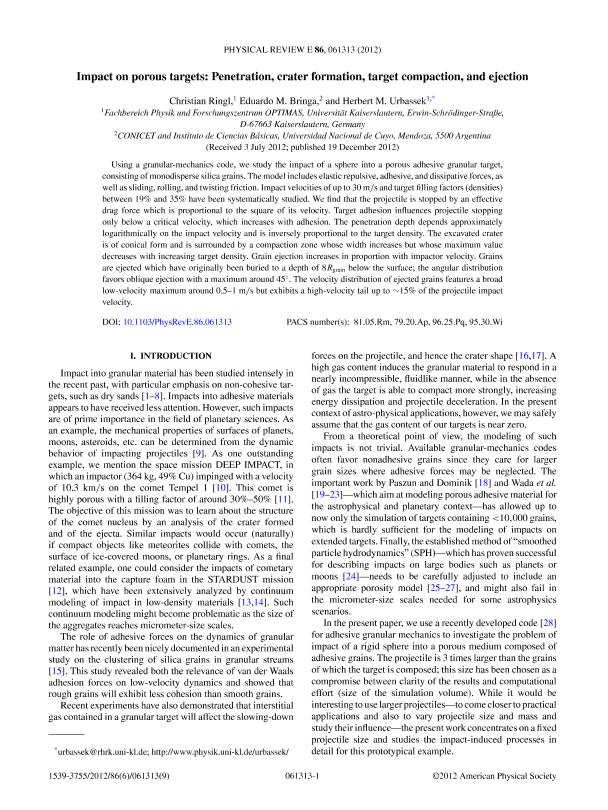Mostrar el registro sencillo del ítem
dc.contributor.author
Ringl, Christian
dc.contributor.author
Bringa, Eduardo Marcial

dc.contributor.author
Urbassek, Herbert M.
dc.date.available
2017-07-13T21:42:07Z
dc.date.issued
2012-12
dc.identifier.citation
Ringl, Christian; Bringa, Eduardo Marcial; Urbassek, Herbert M.; Impact on porous targets: Penetration, crater formation, target compaction, and ejection; American Physical Society; Physical Review E: Statistical, Nonlinear And Soft Matter Physics; 86; 6; 12-2012; 61313-61321
dc.identifier.issn
1539-3755
dc.identifier.uri
http://hdl.handle.net/11336/20473
dc.description.abstract
Using a granular-mechanics code, we study the impact of a sphere into a porous adhesive granular target, consisting of monodisperse silica grains. The model includes elastic repulsive, adhesive, and dissipative forces, as well as sliding, rolling, and twisting friction. Impact velocities of up to 30 m/s and target filling factors (densities) between 19% and 35% have been systematically studied. We find that the projectile is stopped by an effective drag force which is proportional to the square of its velocity. Target adhesion influences projectile stopping only below a critical velocity, which increases with adhesion. The penetration depth depends approximately logarithmically on the impact velocity and is inversely proportional to the target density. The excavated crater is of conical form and is surrounded by a compaction zone whose width increases but whose maximum value decreases with increasing target density. Grain ejection increases in proportion with impactor velocity. Grains are ejected which have originally been buried to a depth of 8Rgrain below the surface; the angular distribution favors oblique ejection with a maximum around 45◦. The velocity distribution of ejected grains features a broad low-velocity maximum around 0.5–1 m/s but exhibits a high-velocity tail up to ∼15% of the projectile impact velocity.
dc.format
application/pdf
dc.language.iso
eng
dc.publisher
American Physical Society

dc.rights
info:eu-repo/semantics/openAccess
dc.rights.uri
https://creativecommons.org/licenses/by-nc-sa/2.5/ar/
dc.subject
Grains
dc.subject
Craters
dc.subject.classification
Astronomía

dc.subject.classification
Ciencias Físicas

dc.subject.classification
CIENCIAS NATURALES Y EXACTAS

dc.title
Impact on porous targets: Penetration, crater formation, target compaction, and ejection
dc.type
info:eu-repo/semantics/article
dc.type
info:ar-repo/semantics/artículo
dc.type
info:eu-repo/semantics/publishedVersion
dc.date.updated
2017-04-07T13:40:22Z
dc.journal.volume
86
dc.journal.number
6
dc.journal.pagination
61313-61321
dc.journal.pais
Estados Unidos

dc.description.fil
Fil: Ringl, Christian. Universität Kaiserslautern; Alemania
dc.description.fil
Fil: Bringa, Eduardo Marcial. Universidad Nacional de Cuyo. Facultad de Ciencias Exactas y Naturales; Argentina. Consejo Nacional de Investigaciones Científicas y Técnicas. Centro Científico Tecnológico Conicet - Mendoza; Argentina
dc.description.fil
Fil: Urbassek, Herbert M.. Universität Kaiserslautern; Alemania
dc.journal.title
Physical Review E: Statistical, Nonlinear And Soft Matter Physics

dc.relation.alternativeid
info:eu-repo/semantics/altIdentifier/doi/http://dx.doi.org/10.1103/PhysRevE.86.061313
dc.relation.alternativeid
info:eu-repo/semantics/altIdentifier/url/https://journals.aps.org/pre/abstract/10.1103/PhysRevE.86.061313
Archivos asociados
